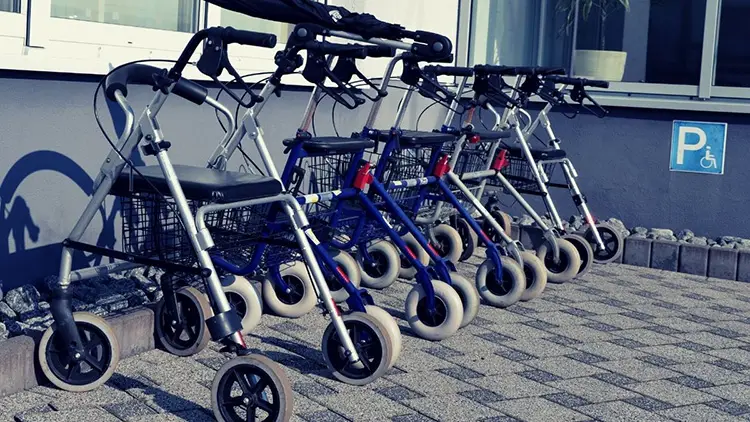Whether it’s a walker, cane, or wheelchair, around 16% of Americans over 65 use a mobility device. If you fall into this category, you likely want to stay as active as possible. If it’s a walker that is being used for mobility, the addition of a seat can easily help you travel further distances, as they allow you to rest when the body demands it.
But how does one choose the best walkers or rollators with seats when so many of them are available on the market? Check out our take on the subject. We’ve analyzed the market, narrowing down the decisions to what we believe are the best of the best.
Features to Consider Before Purchasing
Wheel Diameter
Consider the terrain you will use most with your walker on. Standard rollator wheels are 6-10 inches in diameter. A larger wheel will provide more stability on uneven terrain. If using your walker primarily indoors, 6-7 inches should be fine.
Seat Size
You will want a seat size for comfort and support when taking a break. The most accurate way to measure the appropriate seat size is to measure your bottom on a flat surface and then add an extra inch on each side for the size seat you need.
Height of Handles
The second factor to consider is the height of the walker. Walkers are virtually always adjustable, but only to a point. A walker designed to accommodate somebody up to six feet tall will be obnoxiously uncomfortable for someone who is 6’4” – just short enough to reach the handles, perhaps, but tall enough to have to slouch slightly to do so.
Upright or Regular
Upright rollators encourage the user to stand up straighter, while a regular rollator provides more support and balance. Keep in mind that a regular rollator is more compact, but an upright design could be beneficial if you have orthopedic or back problems.
Storage
Look for a model that allows you to carry things with you. If the rollator you choose doesn’t have this option, you can usually purchase an accessory bag or basket.
Brake Grip
Do the hand grips feel comfortable? Your hands will be spending a lot of time on the handles, so comfort matters. Does the walker seem to aggravate pain rather than alleviate it? Humans are creatures of convenience, and experiencing pain is a barrier to convenience. If you have walker grips that are uncomfortable or painful, you are less likely to use the walker.
Weight
Safety requires that the walker can support the weight of the user. A 350-pound person using a walker with a maximum weight of 200 pounds is dangerous. Most walkers are heavy-duty, but if you or a family member weigh more than the recommended amount, you can special order an appropriate walker.
For more advice on how to pick out the right walker, check out our prior article on the subject.
FAQs About Walkers and Rollators
Many people have questions about their walker or rollator. Here are a few of the most asked questions –
Why Do People Put Tennis Balls on Walkers?
There are two main reasons that people put tennis balls on walkers. For starters, walkers can scuff floors. This isn’t a way to make friends if invited over to one’s house. By putting fuzzy tennis balls on the legs of a traditional walker though this helps to ensure floors (and hosts) stay happy.
The second reason tennis balls are often added to walkers is to reduce the metal chattering noise which is common on traditional walkers.
Is a Rollator Better than a Walker?
Both are functional designs, but a rollator does seem to have some distinct advantages. For starters, a rollator is easier to move. No lifting is required – all one must do is hang onto it and walk. Rollators often have seats on them as well. Walkers do not. However, walkers are typically cheaper than rollators.
Why Does My Walker Hurt My Hands?
This is a common complaint and typically is caused by insufficient padding on the walker handles. With time, existing cushion on walker handles can become compressed or fall off. Replacing the foam can help to disseminate the pressure that is being placed upon the hands better.
Does Medicare Cover Walkers for Seniors?
Yes, Medicare does cover walkers but there are a few caveats that need to be borne in mind. For starters, Medicare will cover the cost of a walker under Medicare Part B as a piece of Durable Medical Equipment (DME).
The catch is that there are a couple of things that need to take place for this piece of DME to be covered. First, a doctor is going to have to prescribe the walker as medically necessary for the patient inside their own home. One can’t just go out and decide they need a walker and expect Medicare to pay for it. Medicare’s pocketbook doesn’t open until the doctor gives the magic word.
The next thing that needs to happen is the walker must be sourced from a supplier who also accepts Medicare. Typically, this isn’t a problem. There are plenty of companies out there which are more than happy to work with Medicare.
The one area where this can be an issue is with upright/stand up walkers. Should you be able to get a prescription for a walker (which is easy) and be able to find an upright walker company that accepts Medicare (which is not easy), then you could have an upright walker covered.
Many upright walker manufacturers refuse to accept Medicare, however Meaning that this is a piece of DME the patient will likely have to pay for out of pocket.
Should you find a walker (upright or otherwise) that Medicare is willing to pay for, keep in mind you’re going to end up paying 20% of the Medicare approved amount.
Are Stand Up Walkers Safe for Seniors?
Speaking of stand-up walkers (aka, upright walkers), many wonder whether they are actually safe to use? Does somebody who has fragile bones and inherent balance difficulties have any reason to use one of these devices?
Absolutely.
There is nothing inherently unsafe about using a stand-up walker. The only negative that these types of walkers have going for them is that they’re new, and thus, people are wary. If the traditional walker design is all one has ever seen for their entire life, it’s strange to trust what seems to be an untested version of a walker for one’s personal safety.
This is unfortunate, as biomechanically speaking, a stand-up walker is a superior design.
As we age, the natural tendency for the human spine is for it to shrink and slouch. This is why seniors are shorter than when they were younger and it is also the reason that so many seniors have a slouched posture.
This slouched posture of the upper spine is known as kyphosis, and aside from further functionally decreasing one’s height, it can also be associated with arthritis, back pain, balance issues, headaches, and decreased shoulder mobility.
Unless the user of a traditional walker is very conscious of their posture, it is all too easy to fall into a kyphotic posture (slouched over) while using a traditional walker. This in turn can lead to further development of kyphosis in the spine.
This is an area where an upright walker really shines, however. By allowing the user to rest their hands or arms at a much higher location than a traditional walker allows, the upright walker forces one into a better postural position. This means one will be less prone to kyphosis and it may even ease back pain that a user typically experiences with a traditional walker.
As far as safety itself goes, there is nothing inherently more unsafe about an upright walker when compared to a traditional walker. If anything, a walker which encourages one to use poor posture is likely to cause more problems than one that doesn’t.
When Should a Senior Use a Wheelchair vs a Walker?
This is a bit of a sticky question that is going to depend on the individual. As always, seek professional medical help before making this decision for oneself. A doctor, physical therapist, or occupational therapist is going to be the first and best source of information as to whether one needs to transition from a walker to a wheelchair.
Here are the factors a licensed medical professional will consider:
1) Has there been a recent change in one’s medical history?
Perhaps it was a recent joint surgery. Maybe somebody just had a stroke which has caused severe weakness or paralysis along the left side. Whatever the reason, a professional is going to look at recent medical events which may have led to their patient not being able to move as safely with a walker as they were previously able to.
There are numerous medical changes that may automatically be the cause for making the shift to a more “severe” form of locomotion assistance. Professional may consider other factors as well, though.
2) Is the patient falling regularly with the walker?
Falling is no small problem for a senior. Osteopenia often accompanies age, and as the bones become more brittle, they become more prone to breaking. A simple fall, which wouldn’t have been anything of note for a 20-year-old, can easily prove to have drastic, lasting consequences for an88-year-old.
After all, it’s to avoid falls that a walker is being used in the first place, is it not? If the walker is not a sufficient source of stability to keep the user from falling, the medical professional very well may recommend a wheelchair instead.
This isn’t typically the first resort of a medical professional after somebody falls with a walker. Physical therapy, walker training, and advice are likely to be what the doctor prescribes first. But if falling with a walker becomes a regular occurrence, then the doctor will issue a safer alternative.
3) Walking is too painful of an activity
A doctor’s goal is typically to keep their patient walking and on their feet for as long as possible. However, there are times when a person’s back pain, knee arthritis, etc. is so severe that the patient can no longer walk safely.
For these people, surgery may be out of the question as well – whether they are on a waiting list, don’t want to go through with the surgery, or the hospital refuses to see them. Whatever the reason, the patient needs a means of locomotion that allows them to move with minimal pain.
In this event, a wheelchair is likely to be prescribed by the doctor. It’s an unfortunate happenstance, but it does allow the patient to continue to be able to move about their house/residence with minimal pain or risk of falling.
5 Recommended Walkers with Seats
We’ve reviewed the different types of walkers and discussed what to look for. Now, you might be wondering about the best brands.? Here is our take –
Elenker Upright Walker
- Back Straight and Remain Active: The height of padded armrest from ground is 38”- 47”, soft padded armrests keep your forearms at a natural level, relieve painful stress on shoulders and back.
- Stability and Security: 10” Front wheels, 360°swivel for easy maneuvering, sturdy enough for indoor and outdoor smooth ride. Ergonomic dual hand brakes and sturdy frame provide better safety.
At the top of our list is the Elenker Upright Walker. While pricier at $200, this is a very highly rated walker which will allow the user to stand in an upright position as they use it. It also offers a nice seating area with backrest for when one’s legs are dictating that it is time to rest.
The entire unit weighs in at 22 pounds – so it may be rather difficult for an individual to pack it into their trunk by themselves – but it can support 300 pounds, meaning this is a great walker for most body types. Under the seat is a storage bag to hold a purse, water bottle, food, or whatever else one may need to tote about as well.
The Elenker walker boasts an indoor/outdoor design with hand brakes, padded forearm rests, and a cane/umbrella holster. Plus, one of its best features is that this walker can easily accommodate a cup holder , making it easy to take your margarita water bottle with you on the go.
- Wheelchair & Walker Cup Holder: Designed to keep drinks within easy reach, this cup holder for wheelchair can also be attached to wheeled walkers, rollators, and transport chairs
- Premium Features: New-and-improved clamp design allows the cup holder to swivel in order to keep contents level
No tools are needed for assembly either, so this is as convenient to set up as possible. All in all, this is a great upright walker with seat that is bound to please.
OasisSpace Upright Walker
- 【Adjustable Armrest】OasisSpace upright walker features an adjustable padded armrest ( 39″ to 46″) can adjust armrest length and holding angle, allowing the seniors, handicap, or disabled to have a more natural position, relieve painful stress on shoulders and back.
- 【Safe and Stable】 The aluminum frame of this upright walker with seat is safe. This walkers for seniors features 10” Metal front wheels and two 8” back wheels can rotate 360° for easy maneuvering.Sturdy enough for indoor and outdoor smooth ride.Ergonomic hand brakes,push forward to slow or stop. It could be effective to avoid customers fall down and brake sensitive.
Virtually identical to the Elenker Upright Walker, but coming in $10 cheaper, is the OasisSpace Upright Walker. All the features are essentially identical. A shopping bag is present underneath the chair, it boasts a wide, plastic back rest, all terrain wheels, and a 300-pound weight limit. In addition, this upright walker easily collapses to fit into your vehicle.
It is heavier than the Elenker – weighing in at around 30 pounds. That makes for a stout walker that may be too much to handle if a caregiver isn’t present while transferring in and out of a vehicle. If this is not an issue though, the OasisiSpace can serve as an excellent upright walker for the thrifty user looking to save money.
Medline Rollator Walker with Seat
- ROLLATOR WALKER WITH SEAT AND 6" WHEELS - The Medline Rollator features a padded seat that allows the user to sit and rest, and smooth rolling 6 inch wheels that are great for indoor or outdoor use
- ROLLING WALKER EASILY FOLDS - Easily fold the Medline Steel Rollator Walker for convenient transport and storage. Rollator weighs 19 lbs
If looking for a more traditional rollator design, the Medline Rollator will fit the bill perfectly. This is about as inexpensive as it gets, coming in at right under $60 as of this writing (early 2022).
It boasts a very functional design. The unit itself is made of steel and only weighs 19 pounds, yet it can easily support up to 350 pounds. When a rest is necessary, the user has access to a thick, padded seat with a steel pipe backrest wrapped in foam. These aren’t as comfortable as the wide plastic backrests offered by other designs, but it isn’t uncomfortable either.
Underneath the seat is the standard storage bag, which can easily hold a water bottle or two. The entire unit also easily folds up and stows in a car trunk with minimal fuss. Assembly is tool-free, and the handles adjust from 31-35”.
All in all, this is a great, no-frills model that will get the job done inexpensively. If you’re looking for a good budget model, this is it.
Drive Medical 10257BL-1
- Rolling Walker with Seat: Stable, strong and stylish, this steel rollator features a durable and supportive frame, a comfortable seat, and an under-seat storage pouch; a great walker for seniors and adults seeking stability in a smaller-than-average footprint
- Wheeled Walker: Four 7.5-inch caster wheels give you a stable roll and are great for outdoor use; a hand brake that can be pressed or pushed down to lock the walker with wheels into place
The Drive Medical features virtually the same characteristics as the Medline Rollator. The biggest differences are the price, number of reviewers, and the backrest (which is bent rather than curved).
This rollator offers the standard cushiony chair, under-chair basket, and hand breaks for nearly the same price as the Medline. It does weigh a pound heavier and has wheels that are 1.5” larger (at 7.5” in height), so it’s not an exact replica.
Perhaps the chief difference is the weight limit. The Drive Medical can safely hold up to 300 pounds, while the Medline has an extra 50-pound capacity. Either way, this is still a great rollator that is sure to get the job done.
And at just a little under $65, this is a rollator that won’t break the bank either.
Medline Premium Empower Rollator
- EXTRA DURABLE FOLDING WALKER —Supports a weight capacity of up to 300 lbs., making it safe and comfortable for the user and their belongings
- EASY-TO-USE BRAKE HANDLES—Ergonomic, adjustable-height handles are easy for seniors and fragile hands to grip without being slippery; push up to brake and push down to lock wheels in place; adjust height 31.5-39.5"
A more expensive, traditional rollator design at around $130, the Medline Premium Empower has some nice features which may make that extra bit of money worth it. For starters, the under-chair basket offers a bit more room, meaning the chair seat doesn’t have to spend most of its time slightly propped open due to lack of space.
The backrest is most certainly an upgrade as well. Rather than leaning against a little, cushioned bar, the user can lean against a large piece of plastic which will better disperse the pressure against the back. In short, the user won’t feel like they’re leaning against a little metal bar.
A memory foam seat is included, which can be lifted up so that the user can actually walk into the walker – allowing them to have the walker for support as they wash their hands at a sink, for example.
The unit weighs in at either 17 or 19 pounds (the manufacturers give both weights), so it’s not overly heavy, and the unit can support up to a 300-pound user. Height-wise, the rollator can be adjusted for those from 4’11” to 6’4”, arguably this would fit most Americans in need of a rollator. The larger, 8” wheels offer more miles before they need to be replaced. The wheels also nest beside each other during the fold up process as well, which means this rollator will take up less volume in your trunk.
And the best part? A cup holder is included! Memory foam and a cup holder? This is the rollator of luxury!
Summary
Healthcare and medical options are confusing, and the world of walkers can often be no different. It’s yet another thing to think about, to ensure that one is making the best choice for themselves or for their loved ones.
With regular walker use, it quickly becomes apparent that there are some simple improvements that could lead to a much more enjoyable experience. Some of these additions may include making your space more efficient with baskets or adding tennis balls on the walker feet to keep from scuffing floors. Whatever additions you may choose, you can assure that your mobility will be improved.











